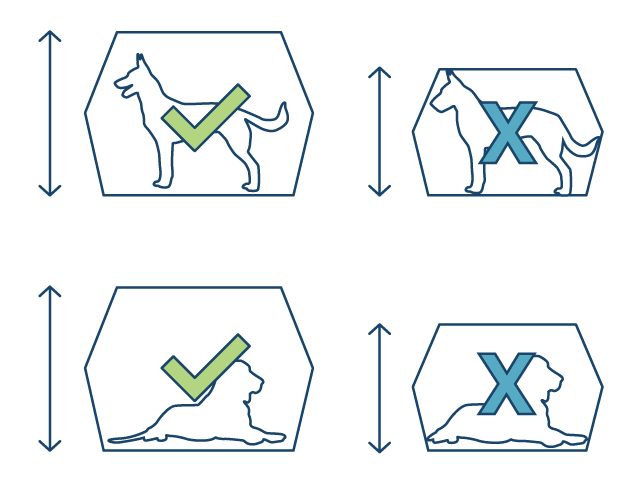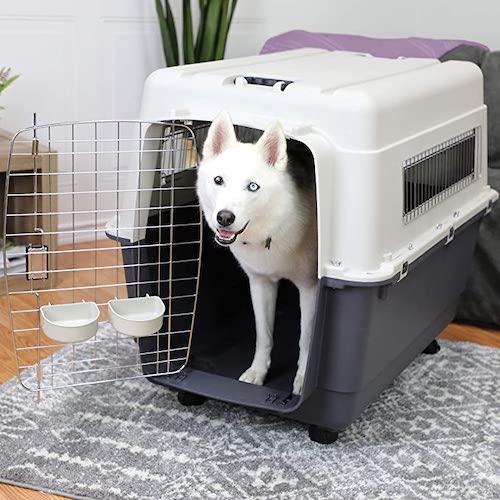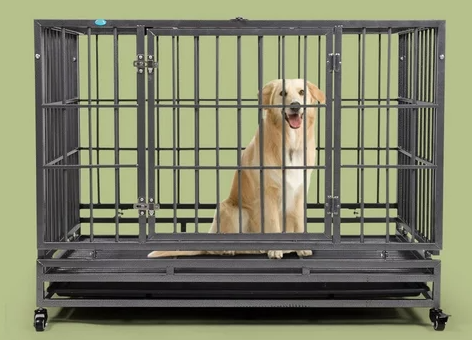Objective
- Understand reasonable in-home boarding accommodations for low-scale operations.
Overview
Kennels
Confinement in kennels can be stressful for some dogs who are not accustomed to the experience. Dogs can show considerable distress (physiological and behavioral), especially during the initial period of kennelling. Many kennelled dogs exhibit repetitive behaviors, including pacing, circling, bouncing, spinning, tail-chasing, and wall bouncing, which suggests that kennels are often suboptimal. Repetitive behavior, however, may have multiple causes and present differently in different contexts and needs to be interpreted cautiously. In general, kennels may be appropriate as a resting area for dogs who have met many of their behavioral and psychological needs outside the kennel (e.g. at work). However, kennels are largely inappropriate as a permanent home.
Crates and Cages
Crates and cages are used to confine dogs within homes, transport vehicles, and veterinary hospitals. These can significantly restrict movement and prevent various species-typical behaviors. Dogs confined in crates or cages should always have room to turn around, stand upright, and lie fully stretched out without touching another animal or the sides of the accommodation. Using crates for short periods of time will allow opportunities outside the crate for other elements of the dog’s daily behavioral repertoire. Nevertheless, even short-term confinement in a cage can cause physiological stress for some dogs. Hence, if kennels or cages are used, even for short periods, stress levels should be reduced by gradually getting animals used to them by pairing the environment with positive experiences.
Predictable Routine
The predictability of daily routines has been shown to be important to dogs in kennels, but this is also likely to be the case for dogs kept in homes. Changes in walking schedules can result in considerable frustration. Similarly, dogs formerly receiving enrichment via feeding devices showed behaviors indicative of frustration and increased physiological stress levels when deprived of them. Routines and provision of enrichment and events that dogs find rewarding should be predictable whenever possible, and interruptions or cessation of routine activities should be avoided.
Routine is particularly relevant for toileting behavior. Most dogs are unwilling to urinate or defecate in their resting place. Training often produces strongly conditioned responses not to urinate or defecate indoors or even on specific surface types. Therefore, dogs are likely to suffer if not given regular opportunities to toilet in suitable places, causing psychological distress and ultimately pain and discomfort. This highlights the importance of a predictable routine and ensuring dogs are regularly removed from any cage to allow toileting and never be restricted so long that they become distressed. Routines must be tailored to the individual’s needs because urination frequencies will likely vary with age.
Minimal Space for Temporary Cages
Commercial Boarding Operations Will Have More Stringent Requirements.
The easy way to estimate if a dog has reasonable room within a cage is to observe if they can stand straight up without their ears touching the top. If the dog can also sit, lay down, turn around, and stretch comfortably, it is safe to say that the kennel falls within most guidelines of best practices for temporary kenneling.
To perform a calculation of minimum space, this formula can be used:
(length of dog in inches + 6) x (length of dog in inches + 6) = required floor space in square inches. Required floor space in inches/144 = required floor space in square feet.
To do this:
- First, find the length of the dog in inches (measured from the tip of its nose to the base of its tail) and then add 6 inches.
- Then, multiply that number by itself. That will give you the floor requirements in square inches.
- Next, you can divide that number by 144 for the square-foot floor requirements.
- Additionally, the interior height of a primary enclosure should be at least 6 inches higher than the head of the dog.
Unacceptable Enclosures for Long Periods
Tethering of dogs is prohibited for use as the primary enclosures by most regulating agencies.
Cages or crates intended for short-term, temporary confinement or travel are unacceptable as primary enclosures and are considered inadequate by most government agencies that regulate long-term boarding.
Enrichment in Kennels
A dog’s environment can be restrictive, uncontrollable, and understimulating. Providing enrichment devices and toys that dogs can chew and play with can add interest to their environment. Play is an important part of the dog’s behavioral repertoire and should be promoted. However, the extent to which dogs utilize toys varies according to type. Toys are generally used more if destructible and chewable, with bones and chew toys being most favored. The potential welfare benefits, therefore, depend on appropriate enrichment devices that the individual dog values.
Dogs should also be walked or allowed free access to an appropriate urination/defecation area at least three times daily. Not only will this prevent distress from the feeling of needing to eliminate, but it will also provide exercise, allowing opportunities to investigate, explore, and potentially interact with other dogs and people.
What's Inside?
- Water bucket
- Soft Bedding (with consideration to destructive chewing and pica)
- Long-lasting chew
- Scheduled treats
- stuffed kong
- bully stick
- treat dispenser
- etc..
- Suggested scheduled feeding
Is the Dog Content?
- Comfort
- thirst
- range of motion
- Stimulation
- sound
- visual
- tactile choices
- Duration in the kennel
- Frustration triggered by audio/visual stimulation
Cage to Cage-Free Time Ratio
- How many dogs are in possession, what time is allotted per dog, and which dogs can be out together?
- Dogs in small cages should have adequate mental and physical activity outside the cage to be conducive to more restful cage time.
- Growing dogs will have structural problems if they spend too much time without moving.
- For situations where the dog will be in a kennel most of the day and night, consider modular kennels designed for more movement and choices.
Other
- Remove collars/equipment that can snag if the dog is left unsupervised.
- Be aware of collars/equipment that can cause pressure sores.
- Avoid cheap kennels. If a dog can bend or break out of the kennel, there is a high risk of injury or death.
- Always address the source of any anxiety - AVOID punishing signs of anxiety.
- Consider zoning laws
- Air exchange and proper sanitation especially when housing multiple dogs in smaller areas.
- Keep all areas SECURE. Ideally use a two-door set up for any exit, including yards.
- Be aware of local laws and regulations.





Responses